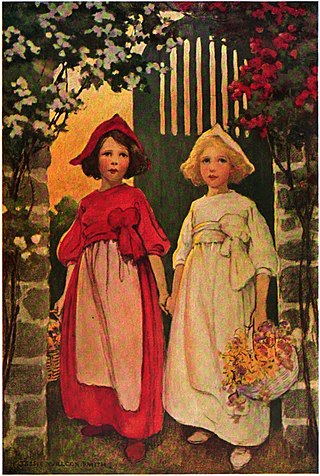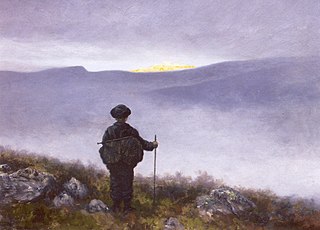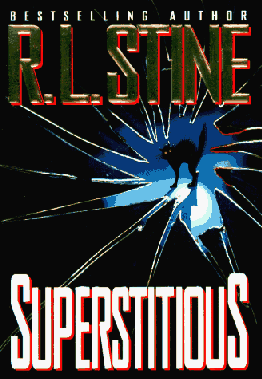
"Sleeping Beauty", also titled in English as The Sleeping Beauty in the Woods, is a fairy tale about a princess cursed by an evil fairy to sleep for a hundred years before being awakened by a handsome prince. A good fairy, knowing the princess would be frightened if alone when she wakes, uses her wand to put every living person and animal in the palace and forest asleep, to awaken when the princess does.

The StoryTeller is a live-action/puppet television series that originally aired in 1987 and which was created and produced by Jim Henson.

"Snow-White and Rose-Red" is a German fairy tale. The best-known version is the one collected by the Brothers Grimm in 1837 in the third edition of their collection Grimm's Fairy Tales. It was first published by Wilhelm Grimm in 1827 in Wilhelm Hauff's Märchen-Almanach. An older, somewhat shorter version, "The Ungrateful Dwarf", was written by Caroline Stahl (1776–1837). Indeed, that appears to be the oldest variant; no previous oral version is known, although several have been collected since its publication in 1818. Oral versions are very limited regionally. The tale is of Aarne-Thompson type 426.
Edith Pattou is an American writer of fantasy fiction, including the novel East, an ALA Top Ten Best Book for Young Adults for 2004. She was born in Evanston, Illinois, and she graduated from the Francis W. Parker School, Scripps College, Claremont Graduate School and UCLA (M.L.I.S.). She is married to Charles Emery, a professor of psychology at Ohio State University. They have one child, a daughter.

"East of the Sun and West of the Moon" is a Norwegian fairy-tale. It was included by Andrew Lang in The Blue Fairy Book (1889).

"The Singing, Springing Lark", "The Singing, Soaring Lark", "The Lady and the Lion" or "Lily and the Lion" is a German fairy tale collected by the Brothers Grimm, appearing as tale no. 88.
"The Three Princesses of Whiteland" is a Norwegian fairy tale, collected by Norwegian writers Peter Christen Asbjørnsen and Jørgen Moe in their collection of folktales and legends Norske folkeeventyr (1879). Scottish poet and novelist Andrew Lang collected it his The Red Fairy Book (1890).
The Brown Bear of Norway is an Irish fairy tale collected by Patrick Kennedy which appeared in his Legendary Fictions of the Irish Celts (1866). It was later included by Andrew Lang in his anthology The Lilac Fairy Book (1910), though Lang misattributed his source as West Highland Tales.

Soria Moria Castle is a Norwegian fairy tale made famous by Peter Christen Asbjørnsen and Jørgen Moe in their classical Norske Folkeeventyr. Later Andrew Lang included the story in his series of fairy tale collections in The Red Fairy Book.
The Blue Belt is a Norwegian fairy tale collected by Peter Christen Asbjørnsen and Jørgen Moe in Norske Folkeeventyr. It is Aarne-Thompson type 590.

White-Bear-King-Valemon is a Norwegian fairy-tale. The tale was published as No. 90 in Asbjørnsen and Moe's Norske Folke-Eventyr. Ny Samling (1871). George Webbe Dasent translated it for his Tales from the Fjeld.

Superstitious is a 1995 horror novel by author R. L. Stine. This was the first adult novel by Stine, most famous for writing children's fiction such as the Goosebumps series. This book deals with Sara Morgan, who falls in love with Liam O’Connor. It was published on September 14, 1995 by Grand Central Publishing in the United States.

The Polar Bear King is a 1991 Norwegian fantasy adventure film directed by Ola Solum and starring Jack Fjeldstad, Maria Bonnevie, Tobias Hoesl, Monica Nordquist, and Anna-Lotta Larsson. The film is based on the Norwegian fairy tale The White Bear, King Valemon.

Ice is a novel written by Sarah Beth Durst, a modernized retelling of the Norwegian fairy tale East of the Sun and West of the Moon. It was a nominee for the Andre Norton Award in 2009.
Whitebear Whittington or White Bear Whittington is a character that appears in American folktales. He sometimes appears as a bear that marries a human maiden, in folktales of the Animal as Bridegroom type, a set of tales related to Cupid and Psyche.

Two Pieces of Nuts is a Hungarian folktale collected by István Banó in Baranya. In it, a woman promises to give birth to wonderful children who are subsequently taken from her by jealous associates or relatives.
The Beautiful Palace East of the Sun and North of the Earth is a Swedish folktale collected from Smaland by Swedish folktale collectors George Stephens and Gunnar Olof Hyltén-Cavallius. It features versions of the swan maiden, a mythic female character that alternates between human and animal shapes.
Again, The Snake Bridegroom is a Serbian folktale collected in the 19th century by Serbian philologist Vuk Karadžić, featuring the marriage between a human maiden and a husband in serpent guise.
Maid Lena is a Danish folktale collected by author Svend Grundtvig. It features versions of the swan maiden, a mythic female character that alternates between human and animal shapes.
West is a young adult fantasy novel written by Edith Pattou and published by Houghton Mifflin Harcourt. The book is the sequel to East.











